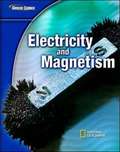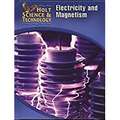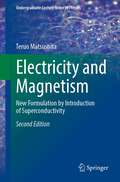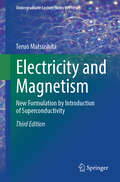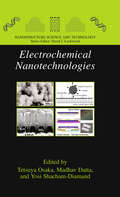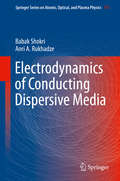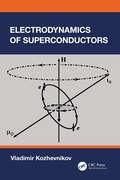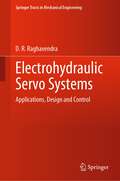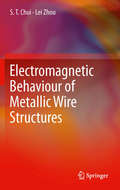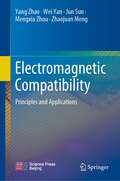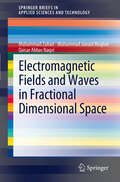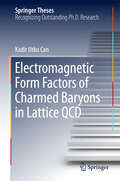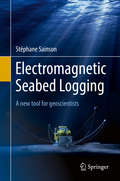- Table View
- List View
Electricity and Magnetism
by Glencoe Mcgraw-HillDiscover the Flexibility to Teach Science Your Way!. "Glencoe Science: Electricity and Magnetism," a module in the Glencoe Science 15 book series, provides students with accurate and comprehensive coverage of middle school National Science Education Standards. Concepts are explained in a clear, concise manner, and are integrated with a wide range of hands-on experiences, critical thinking opportunities, real-world applications, and connections to other sciences and to non-science areas of the curriculum. Co-authored by National Geographic, unparalleled graphics reinforce key concepts. A broad array of print and technology resources help differentiate and accommodate all learners. The modular approach allows you to mix and match books to meet your specific curriculum needs.
Electricity and Magnetism
by Teruo MatsushitaThe author introduces the concept that superconductivity can establish a perfect formalism of electricity and magnetism. The correspondence of electric materials that exhibit perfect electrostatic shielding (E=0) in the static condition and superconductors that show perfect diamagnetism (B=0) is given to help readers understand the relationship between electricity and magnetism. Another helpful aspect with the introduction of the superconductivity feature perfect diamagnetism is that the correspondence in the development of the expression of magnetic energy and electric energy is clearly shown. Additionally, the basic mathematical operation and proofs are shown in an appendix, and there is full use of examples and exercises in each chapter with thorough answers.
Electricity and Magnetism: Holt Science & Technology Short Course N
by Holt Rinehart Winston StaffThe book has a Reading Warm-Up at the beginning of every section provides the student with the section's objectives and key terms. A Reading Strategy at the beginning of every section provides tips to help students organize and remember the information covered in the section.
Electricity and Magnetism: New Formulation by Introduction of Superconductivity (Undergraduate Lecture Notes in Physics)
by Teruo MatsushitaThis book is a very comprehensive textbook covering in great depth all the electricity and magnetism. The 2nd edition includes new and revised figures and exercises in many of the chapters, and the number of problems and exercises for the student is increased.In the 1st edition, emphasis much was made of superconductivity, and this methodology will be continued in the new edition by strengthening of the E-B analogy. Many of the new exercises and problems are associated with the E-B analogy, which enables those teaching from the book to select suitable teaching methods depending on the student’s ability and courses taken, whether physics, astrophysics, or engineering.Changes in the chapters include a detailed discussion of the equivector-potential surface and its correspondence between electricity and magnetism. The shortcomings of using the magnetic scalar potential are also explained. The zero resistivity in a magnetic material showing perfect diamagnetism can be easily proved.This textbook is an ideal text for students, who are competent in calculus and are taking physics, astrophysics, or engineering at degree level. It is also useful as a reference book for the professional scientist.
Electricity and Magnetism: New Formulation by Introduction of Superconductivity (Undergraduate Lecture Notes in Physics)
by Teruo MatsushitaThis comprehensive textbook covers electricity and magnetism in great depth, with the 3rd edition offering updated descriptions of electromagnetic phenomena to help students achieve a more thorough understanding of the subject. In the 1st edition, superconductivity was emphasized, a focus that continued in the 2nd edition, which strengthened the E-B analogy by comparing equipotential surfaces in electricity to equivector potential surfaces in magnetism. The 3rd edition introduces the concept of mean magnetic flux, which aids in determining inductance from magnetic energy. It also demonstrates how vector potential can be directly used to calculate electromotive force. A unique phenomenon is presented when applying current to a superconducting transmission line, where the induced electric field's vector potential is perpendicular to the current. This deviation from common equations can still be explained through Maxwell&’s theory, leading to the correct solution. For a more in-depth grasp of electricity and magnetism, students are encouraged to use Exercises in Electricity and Magnetism by the same author, which offers 400 practice problems. This textbook is ideal for advanced students of physics, astrophysics, or engineering, as well as a valuable reference for professional scientists.
Electrifying Atmospheres: Charging, Ionisation and Lightning in the Solar System and Beyond
by Karen L. AplinElectrical processes take place in all planetary atmospheres. There is evidence for lightning on Venus, Jupiter, Saturn, Uranus and Neptune, it is possible on Mars and Titan, and cosmic rays ionise every atmosphere, leading to charged droplets and particles. Controversy surrounds the role of atmospheric electricity in physical climate processes on Earth; here, a comparative approach is employed to review the role of electrification in the atmospheres of other planets and their moons. This book reviews the theory, and, where available, measurements, of planetary atmospheric electricity, taken to include ion production and ion-aerosol interactions. The conditions necessary for a global atmospheric electric circuit similar to Earth's, and the likelihood of meeting these conditions in other planetary atmospheres, are briefly discussed. Atmospheric electrification is more important at planets receiving little solar radiation, increasing the relative significance of electrical forces. Nucleation onto atmospheric ions has been predicted to affect the evolution and lifetime of haze layers on Titan, Neptune and Triton. For planets closer to Earth, heating from solar radiation dominates atmospheric circulations. Mars may have a global circuit analogous to the terrestrial model, but based on electrical discharges from dust storms, and Titan may have a similar global circuit, based on transfer of charged raindrops. There is an increasing need for direct measurements of planetary atmospheric electrification, in particular on Mars, to assess the risk for future unmanned and manned missions. Theoretical understanding could be increased by cross-disciplinary work to modify and update models and parameterisations initially developed for a specific atmosphere, to make them more broadly applicable to other planetary atmospheres. The possibility of electrical processes in the atmospheres of exoplanets is also discussed.
Electrochemical Nanotechnologies
by Madhav Datta Yosi Shacham-Diamand Tetsuya OsakaIn this book, the term "electrochemical nanotechnology" is defined as nanoprocessing by means of electrochemical techniques. This introductory book reviews the application of electrochemical nanotechnologies with the aim of understanding their wider applicability in evolving nanoindustries. These advances have impacted microelectronics, sensors, materials science, and corrosion science, generating new fields of research that promote interaction between biology, medicine, and microelectronics. This volume reviews nanotechnology applications in selected high technology areas with particular emphasis on advances in such areas. Chapters are classified under four different headings: Nanotechnology for energy devices - Nanotechnology for magnetic storage devices - Nanotechnology for bio-chip applications - Nanotechnology for MEMS/Packaging.
Electrochemical Perspective Towards Wastewater Treatment (Advances in Wastewater Research)
by Sanjay Kumar Maulin P. Shah Ila Jogesh Ramala SarkarThis book presents electrochemical water treatment methods, which offer ways to find more sustainable solutions. The majority of electrochemical water treatment methods use electricity as the main reactant to conduct the treatment process. Among well-developed electrochemical water treatment methods such as electrocoagulation, electroflotation, electrodialysis, electrochemical oxidation-reduction, there are evolving methods, which show good pre fundamentals for their use in industry-scale applications. These methods increase the removal rates of pollutants, remove drawbacks, extend the applicability of existing electrochemical water treatment methods, and improve cost-efficiency. This book also delivers the improved and enhanced innovative techniques which are economical and efficient for wastewater treatment industry. In addition, the book will envisage the future potential of electrochemical treatment adaptation and a protocol for achieving graded water flexibility and a sustainable future. The main typical reactors used for electrochemical water treatment methods are discussed in this book. Moreover, the volume includes some examples of electrochemical water treatment methods in practice and the activities of some companies working in the field of water treatment. At the same time, design solutions for reactors of developing electrochemical processes are still in the stage of optimization and development, which are presented in the book. There is often a difficulty in selecting the right size of equipment for the treatment of water with given flow rates and concentration of pollutants. This book focuses on the challenges and future tendencies for this highly efficient technology to reach the full-scale implementations as well.
Electrochemically Assisted Remediation of Contaminated Soils: Fundamentals, Technologies, Combined Processes and Pre-Pilot and Scale-Up Applications (Environmental Pollution #30)
by M. A. Rodrigo E. V. Dos SantosThis book provides an overview of the current development status of remediation technologies involving electrochemical processes, which are used to clean up soils that are contaminated with different types of contaminants (organics, inorganics, metalloids and radioactive). Written by internationally recognized experts, it comprises 21 chapters describing the characteristics and theoretical foundations of various electrochemical applications of soil remediation. The book’s opening section discusses the fundamental properties and characteristics of the soil, which are essential to understand the processes that can most effectively remove organic and inorganic compounds. This part also focuses on the primary processes that contribute to the application of electrochemically assisted remediation, hydrodynamic aspects and kinetics of contaminants in the soil. It also reviews the techniques that have been developed for the treatment of contaminated soils using electrochemistry, and discusses different strategies used to enhance performance, the type of electrode and electrolyte, and the most important operating conditions. In turn, the book’s second part deals with practical applications of technologies related to the separation of pollutants from soil. Special emphasis is given to the characteristics of these technologies regarding transport of the contaminants and soil toxicity after treatment. The third part is dedicated to new technologies, including electrokinetic remediation and hybrid approaches, for the treatment of emerging contaminants by ex-situ and in-situ production of strong oxidant species used for soil remediation. It also discusses pre-pilot scale for soil treatment and the use of solar photovoltaic panels as an energy source for powering electrochemical systems, which can reduce both the investment and maintenance costs of electrochemically assisted processes.
Electrode Materials for Energy Storage and Conversion
by Mesfin A. KebedeThis book provides a comprehensive overview of the latest developments and materials used in electrochemical energy storage and conversion devices, including lithium-ion batteries, sodium-ion batteries, zinc-ion batteries, supercapacitors and conversion materials for solar and fuel cells. Chapters introduce the technologies behind each material, in addition to the fundamental principles of the devices, and their wider impact and contribution to the field. This book will be an ideal reference for researchers and individuals working in industries based on energy storage and conversion technologies across physics, chemistry and engineering. FEATURES Edited by established authorities, with chapter contributions from subject-area specialists Provides a comprehensive review of the field Up to date with the latest developments and research Editors Dr. Mesfin A. Kebede obtained his PhD in Metallurgical Engineering from Inha University, South Korea. He is now a principal research scientist at Energy Centre of Council for Scientific and Industrial Research (CSIR), South Africa. He was previously an assistant professor in the Department of Applied Physics and Materials Science at Hawassa University, Ethiopia. His extensive research experience covers the use of electrode materials for energy storage and energy conversion. Prof. Fabian I. Ezema is a professor at the University of Nigeria, Nsukka. He obtained his PhD in Physics and Astronomy from University of Nigeria, Nsukka. His research focuses on several areas of materials science with an emphasis on energy applications, specifically electrode materials for energy conversion and storage.
Electrodeposition
by Stojan S. DjokicIn the past few decades, research in the science of electrodeposition of metals has shown the important practical applications of electronic, magnetic, energy devices and biomedical materials. The aim of this new volume is to review the latest developments electrodeposition and present them to teachers, professionals, and students working in the field.
Electrodynamics and Special Theory of Relativity
by Reiner M. Dreizler Cora S. LüddeThis textbook offers you a profound understanding of the core concepts in electrodynamics and the special theory of relativity. Emphasis is placed on establishing strong mathematical fundamentals while also equipping you with problem-solving skills crucial for mastering these disciplines. It covers electromagnetic theory, encompassing Maxwell's equations and electromagnetic wave theory as well as special theory of relativity, including space-time principles and the Lorentz transformation.
Electrodynamics of Conducting Dispersive Media (Springer Series on Atomic, Optical, and Plasma Physics #111)
by Babak Shokri Anri A. RukhadzeThis book presents a sequential representation of the electrodynamics of conducting media with dispersion. In addition to the general electrodynamic formalism, specific media such as classical nondegenerate plasma, degenerate metal plasma, magnetoactive anisotropic plasma, atomic hydrogen gas, semiconductors, and molecular crystals are considered.The book draws on such classics as Electrodynamics of plasma and plasma-like media (Silin and Rukhadze) and Principles of Plasma Electrodynamics (Alexandrov, Bogdankevich, and Rukhadze), yet its outlook is thoroughly modern—both in content and presentation, including both classical and quantum approaches. It explores such recent topics as surface waves on thin layers of plasma and non-dispersive media, the permittivity of a monatomic gas with spatial dispersion, and current-driven instabilities in plasma, among many others. Each chapter is equipped with a large number of problems with solutions that have academic and practical importance. This book will appeal to graduate students as well as researchers and other professionals due to its straight-forward yet thorough treatment of electrodynamics in conducting dispersive media.
Electrodynamics of Density Ducts in Magnetized Plasmas: The Mathematical Theory of Excitation and Propagation of Electromagnetic Waves in Plasma Waveguides
by I G Kondratiev A V Kudrin T M ZaboronkovaProviding a systematic and self-contained treatment of excitation, propagation and re- emission of electromagnetic waves guided by density ducts in magnetized plasmas, this book describes in detail the theoretical basis of the electrodynamics of ducts. The classical dielectric-waveguide theory in open guiding systems in magnetoplasma is subjected to rigorous generalization. The authors emphasize the conceptual physical and mathematical aspects of the theory, while demonstrating its applications to problems encountered in actual practice. The opening chapters of the book discuss the underlying physical phenomena, outline some of the results obtained in natural and artificial density ducts, and describe the basic theory crucial to understanding the remainder of the book. The more specialized and complex topics dealt with in subsequent chapters include the theory of guided wave propagation along axially uniform ducts, finding the field excited by the source in the presence of a duct, excitation of guided modes, the asymptotic theory of wave propagation along axially nonuniform ducts, and mode re-emission from a duct. The full wave theory is used throughout most of the book to ensure consistency, and the authors start with simpler cases and gradually increase the complexity of the treatment.
Electrodynamics of Superconductors
by Vladimir KozhevnikovSuperconductivity is a remarkable, on the verge of miraculous, macroscopic quantum phenomenon with a boundless potential for a wide variety of applications. Over the last century the physics of superconductivity constitutes a major part of research in condensed matter and yet the electrodynamics of superconductors appears as only a minor part in textbooks on electrodynamics and superconductivity. The book offers a fresh look at electrodynamics of continuous media with detailed description of thermal and electromagnetic properties of superconductors, emphasising physical meaning of concepts and principles without excessive mathematics. To facilitate understanding, it is accompanied by problems and worked solutions. The book will be of interest to senior undergraduate and graduate students of physics and chemistry who have taken a calculus-based course in general physics. It is a valuable reference for researchers involved in studies of superconductivity, the physics of metals, and condensed matter physics.Key Features: The first book - in terms of semi-classical physics - addressing both equilibrium and nonequilibrium, thermal and transport properties of superconducting materials Presents an accessible overview without excessive mathematics Accompanied by problems with solutions to aid understanding
Electrohydraulic Servo Systems: Applications, Design and Control (Springer Tracts in Mechanical Engineering)
by D. R. RaghavendraThis book covers the fundamental concepts of electrohydraulic (EH) servo systems in detail and also presents the developments about power, quadratic response, and control flexibility of EH servo systems with applications in aircraft/aerospace engineering, mobile equipment, material/structure testing, motion simulators, and strategic defense sectors. Various topics covered in this books are systems and configurations of servo systems, components, applications, design of SISO and MIMO and control options of SISO and MIMO systems. It further includes a chapter on contamination control, fault detection and diagnosis (FDD) of these systems. The detailed working procedures and advice on implementation routines presented in this book will help readers to apply the control models and systems presented so as to make their own servo systems more efficient. The book will be useful for mechanical engineers and professionals involved in the analysis and design of electrohydraulic control systems, especially in advanced hydraulic industries, the aeronautical and space, and automotive industries. It would also be a useful reference for advanced courses in EH systems.
Electrokinetics Across Disciplines and Continents
by Alexandra B. Ribeiro Eduardo P. Mateus Nazaré CoutoThe socio-economic activities due to world development are promoting increasing pressures on land, creating competition and conflicts, resulting in suboptimal use of resources. Integrated planning and management of land resources is a top subject of Agenda 21 (managed by FAO), which deals with the cross-sectoral aspects of decision-making for the sustainable use and development of natural resources. This is essential for life-support systems and its productive capacity. In this context, there is a need to find new strategies for sustainable development that links social and economic progress with environmental protection and enhancement. Electrokinetic transport processes (EK) uses a low-level direct current as the "cleaning agent". EK has been applied to the remediation of polluted soils and other contaminated matrices. It also shows a great potential to be used in different fields, as in saline soil restoration, nutrients recovery from wastes or repair and maintenance of building structures. EK may be an integrated approach for new strategies aiming at sustainable development and to support waste strategies, with worldwide interest. EK can also be coupled with phytoremediation and integrated with nanotechnology, enlarging the scope of its application. The conciliation of the EK in the recovery of secondary resources, remediation and conservation is a multidisciplinary novel approach that opens new technical possibilities for waste minimization, through upgrading of particulate waste products and the recovery of secondary resources for industrial, agricultural or social use.
Electromagnetic Behaviour of Metallic Wire Structures
by Lei Zhou S. T. ChuiDespite the recent development and interest in the photonics of metallic wire structures, the relatively simple concepts and physics often remain obscured or poorly explained to those who do not specialize in the field. Electromagnetic Behaviour of Metallic Wire Structures provides a clear and coherent guide to understanding these phenomena without excessive numerical calculations. Including both background material and detailed derivations of the various different formulae applied, Electromagnetic Behaviour of Metallic Wire Structures describes how to extend basic circuit theory relating to voltages, currents, and resistances of metallic wire networks to include situations where the currents are no longer spatially uniform along the wire. This lays a foundation for a deeper understanding of the many new phenomena observed in meta-electromagnetic materials. Examples of applications are included to support this new approach making Electromagnetic Behaviour of Metallic Wire Structures a comprehensive and self-contained volume suitable for use by specialists, non-specialist, researchers and professionals in other relevant fields and even students.
Electromagnetic Compatibility: Principles and Applications
by Yang Zhao Wei Yan Jun Sun Mengxia Zhou Zhaojuan MengThis book highlights principles and applications of electromagnetic compatibility (EMC). After introducing the basic concepts, research progress, standardizations and limitations of EMC, the book puts emphasis on presenting the generation mechanisms and suppression principles of conducted electromagnetic interference (EMI) noise, radiated EMI noise, and electromagnetic susceptibility (EMS) problems such as electrostatic discharge (ESD), electric fast transient (EFT) and surge. By showing EMC case studies and solved examples, the book provides effective solutions to practical engineering problems. Students and researchers will be able to use the book as practical reference for EMC-related measurements and problem- solution.
Electromagnetic Distance Measurement
by International Association of GeodesyElectromagnetic distance measurement, by using light and microwaves for direct linear measurements and thus circumventing the need for traditional methods of triangulation, may well introduce a new era in surveying. This book brings together the work of forty-eight geodesists from twenty-five countries. They discuss various new EDM instruments—among them the Tellurometer, Geodimeter, and air- and satellite-borne systems—and investigate the complex sources of error. The book is therefore a unique and comprehensive source on the subject. UNESCO and R.I.C.S. have assisted financially in its production.
Electromagnetic Fields and Waves in Fractional Dimensional Space
by Muhammad Zubair Qaisar Abbas Naqvi Muhammad Junaid MughalThis book presents the concept of fractional dimensional space applied to the use of electromagnetic fields and waves. It provides demonstrates the advantages in studying the behavior of electromagnetic fields and waves in fractal media. The book presents novel fractional space generalization of the differential electromagnetic equations is provided as well as a new form of vector differential operators is formulated in fractional space. Using these modified vector differential operators, the classical Maxwell's electromagnetic equations are worked out. The Laplace's, Poisson's and Helmholtz's equations in fractional space are derived by using modified vector differential operators.
Electromagnetic Form Factors of Charmed Baryons in Lattice QCD (Springer Theses)
by Kadir Utku CanThis thesis presents the first lattice quantum chromodynamics (QCD) approach to the charmed baryon regime, building on the knowledge and experience gained with former lattice QCD applications to nucleon structure. The thesis provides valuable insights into the dynamics of yet unobserved charmed baryon systems. Most notably, it confirms that the expectations of model or effective field theoretical calculations of heavy-hadron systems hold qualitatively, while also demonstrating that they conflict with the quantitative results, pointing to a tension between these complementary approaches. Further, the book presents a cutting-edge approach to understanding the structure and dynamics of hadrons made of quarks and gluons using QCD, and successfully extends the approach to charmed hadrons. In particular, the thesis investigate a peculiar property of charmed hadrons whose dynamics, i.e., structure, deviates from their counterparts, e.g., those of protons and neutrons, by employing the lattice QCD approach —a state-of-the-art numerical method and the powerful ab initio, non-perturbative method.
Electromagnetic Metamaterials and Metasurfaces: From Theory To Applications
by Yan Shi Tie Jun Cui Long LiThe subject of this book is the fast-developing area of research known as metamaterials/metasurfaces and some of their engineering applications. This book comprehensively presents the state of the art of metamaterials/metasurfaces from theory to applications. The theoretical side includes electrodynamics of left-handed medium, generalized Snell's law, digital coding metamaterials/metasurfaces, group theory of metamaterials, information metamaterials and metasurfaces, etc. On the application side, a wide range of design examples are discussed, including metamaterial antennas, electromagnetic interference, frequency selective surfaces, wireless power transmission and energy harvesting, cloaking and radar cross section reduction, orbital angular momentum, wireless communication, imaging, etc. The book provides researchers, engineers, and graduate students with a variety of new discoveries, results, information, and knowledge in the field of metamaterials and metasurfaces.
Electromagnetic Metamaterials: Modern Insights into Macroscopic Electromagnetic Fields (Springer Series in Materials Science #287)
by Kazuaki SakodaThis book presents novel and fundamental aspects of metamaterials, which have been overlooked in most previous publications, including chirality, non-reciprocity, and the Dirac-cone formation. It also describes the cutting-edge achievements of experimental studies in the last several years: the development of high-regularity metasurfaces in optical frequencies, high-performance components in the terahertz range, and active, chiral, nonlinear and non-reciprocal metamaterials in the microwave range. Presented here are unique features such as tunable metamaterials based on the discharge plasma, selective thermal emission from plasmonic metasurfaces, and the classical analogue of the electromagnetically induced transparency. These most advanced research achievements are explained in understandable terms by experts in each topic. The descriptions with many practical examples facilitate learning, and not only researchers and experts in this field but also graduate students can read the book without difficulty. The reader finds how these new concepts and new developments are being utilized for practical applications.
Electromagnetic Seabed Logging
by Stéphane SainsonSeabed logging (SBL) gathers the electromagnetic methods of marine subsoil exploration and more specifically those dedicated to the exploration of oil and gas at sea.Appeared in 2000, these techniques, with more than 500 industrial jobs, present after 15 years of commercial success a discovery record rate of nearly 90 % and seem now to turn the world in the offshore exploration field.Proposing a serious index of the presence of hydrocarbons , electromagnetic SBL coupled with seismic reflection survey is probably the first reliable method for direct detection of hydrocarbons. Complementing the structural concepts of oil exploration used since the 1920s, the SBL now radically modifies the approach and the philosophies of exploration especially those then including drilling and well logging activities. Electromagnetic Seabed Logging: a new tool for oil and gas prospecting, which original publication in French was in 2012, presents these methods, its principles, advantages, limitations, instruments, modeling and applications. It is also designed to be a tool for a reflection on the use of electromagnetic energy for the exploration in a conductive medium as sea water thus setting the theoretical and practical limits of these investigations for future developments. This book is intended of course for the geophysicists and the petroleum geologists, but also for the earth scientists, the reservoir engineers and the log analysts
